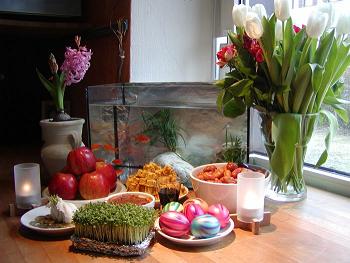

Nowrouz
Nowrouz is certainly the most important event for all Iranians during the year. For years, Iranian and the neighbors (a part of Iran a few centuries ago) observe Nowrouz holidays which very vibrant for everyone. Of course, there is no such thing as a festival or what you may expect in western countries. The celebration happens within the family and relatives. It is time for reunion. Even these days, despite of lots of difficulties in life, most people observe the same customs. In the New Year, Iranians start cleaning the entire house, go shopping and buy new clothes at least for the younger ones. The schools and universities are closed for more than 2 weeks and employees have 6 days off. So it is best time to travel round the country. Richer ones reserve hotels and book flights and trains very much in advance. Other use bus or train. But is that enough for whole country being on the move? Certainly not!
It is crystally clear that the hotels and the transportation system cannot support such a swarm of local travelers.
What then? It is common practice that people use their private cars and travel to different cities while camping in the park or in temporary residential places specifically intended for Nowruz trips.
Of course, some hate the traffic and crowded road but it is really nice and agile for many others. All the cities enjoy this moving population but some cities like Shiraz, Mashad, and Isfahan get the most visitors (Sometimes more than a million in less than 2 weeks). Still some others prefer to stay at home at least for a part of the holidays.
There are two famous customs related to Nowrouz; one is called “Haft Sin” means “Seven S” refers to an exquisitely arranged tablecloth with seven things starting with S on it. These may usually includes Sanzeh (grown wheat), Sib (apple), Sekke (coin), Somagh (sumac), Sir (garlic), Senjed (sea-buckthorn), Samanu (some sweet desert). In addition, mirror, the holy book, colored eggs and a small red fish are also necessary. On the New Years Eve, the whole family or a group of relatives usually sit around the tablecloth “Sofre Haft Sin” and prays and makes good wishes a the outset of the New Year. As soon as the New Year begins, they stand up and kiss each other, eat sweets and give “Eydi” (some money usually newly-printed bills) to younger ones.
The second very common custom is visiting relatives, friends and acuintances and then visiting back. This is called “did o bazdid” means visiting and visiting back. The relatives who probably haven’t seen each other much, go to each other house for a short visit and stay talking and eating special sweets, then visit other houses. This starts from the house of the eldest member of the whole family and then in turn they should visit them back. Sometimes it is very quick, you visit them on the first day, and they visit back on the second or third day. Some do not observe the custom as strictly as before but it is still common to visit a couple of houses in one day especially in smaller cities. Sounds strange?
But it is really nice and helps families revive their intimacy.
Although, life has become much more difficult in the recent years but Iranians still cherish these customs and enjoy them. That is particularly a great time for children. All of us remember the New Year as the most enjoyable part of our childhood. Oh memories!
